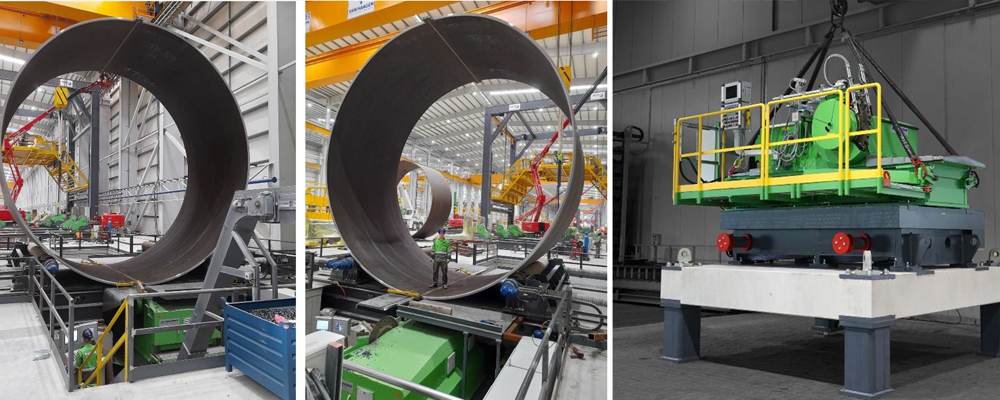
With the expansion at the production site in Bilbao, Haizea is making the port one of the most important locations in southern Europe for the construc
With the expansion at the production site in Bilbao, Haizea is making the port one of the most important locations in southern Europe for the construction of offshore wind towers and their foundation structures (monopiles)
Germany/Spain. Haizea Wind Group (Haizea), which was founded in 2017, has been working with Graebener right from the start. In 2018 Graebener already supplied a 55kW longitudinal seam milling machine and two 55kW circumferential seam milling machines for Haizea's wind tower production in Bilbao. Haizea is now entering the monopile market and is once again relying on two further milling machines for weld seam preparation from the custom machine builder from Germany - this time with a recently developed pipe turning device for turning and positioning cylindrical and conical pipes, which is used to align the pipes above the longitudinal seam milling machine for seam processing. The pipe weight can be up to 125 tons.
Haizea is a global player in the onshore and offshore industry. The company has been manufacturing giant wind towers in the port of Bilbao since 2018. By entering into monopile production, the company is expanding this facility by adding another hall segment. Production is scheduled to start in the second quarter of this year.
Graebener supplied a 55kW longitudinal seam milling machine including an innovative pipe turning device, which is designed for turning and positioning cones. The scope of supply further includes a 55kW circumferential seam milling machine with a special height adapter and a substructure that enables the circ seam milling machine to be positioned and aligned quickly to the circumferential seams of the monopile sections to be processed by means of a self-propelled modular transporter (SPMT). The machines are designed to prepare the connecting seams of the huge cones and cylinders that make up the monopiles for the submerged arc welding process.
Monopiles, in turn, are foundations for offshore wind farms - large steel columns with a wall thickness of up to 150mm, diameters of up to 15m, lengths of up to 100m and unit weights of up to 2,500t.
Optimum conditions for economical weld seam preparation with large wall thicknesses
Monopiles consist of a large number of steel rings (pipe sections) that are welded together. Due to their huge diameters of up to 15m, the sections are made from several individual plates. This production method results in both longitudinal and circumferential seams: Longitudinal seams during the production of the shells, circumferential seams when joining the sections together. Both inside and outside edges must be precisely beveled prior to welding the individual parts together. The more precise the bevels, the more resilient the weld seams and therefore the complete monopile will be.
The Graebener seam milling process provides a uniform joint width and depth over the entire circumference of the pipe. Further, the precisely milled joints allow an uncomplicated visual inspection of the internal root of the weld seam without prior cleaning, enabling the quality of the internal weld seam to be visually inspected directly. This means that weld seam defects can be reduced to 0%. Last but not least, automatic seam preparation is a necessary requirement for an automatic multi-wire submerged arc welding process, given the fact that the seam detection sensor requires clean joint edges.
